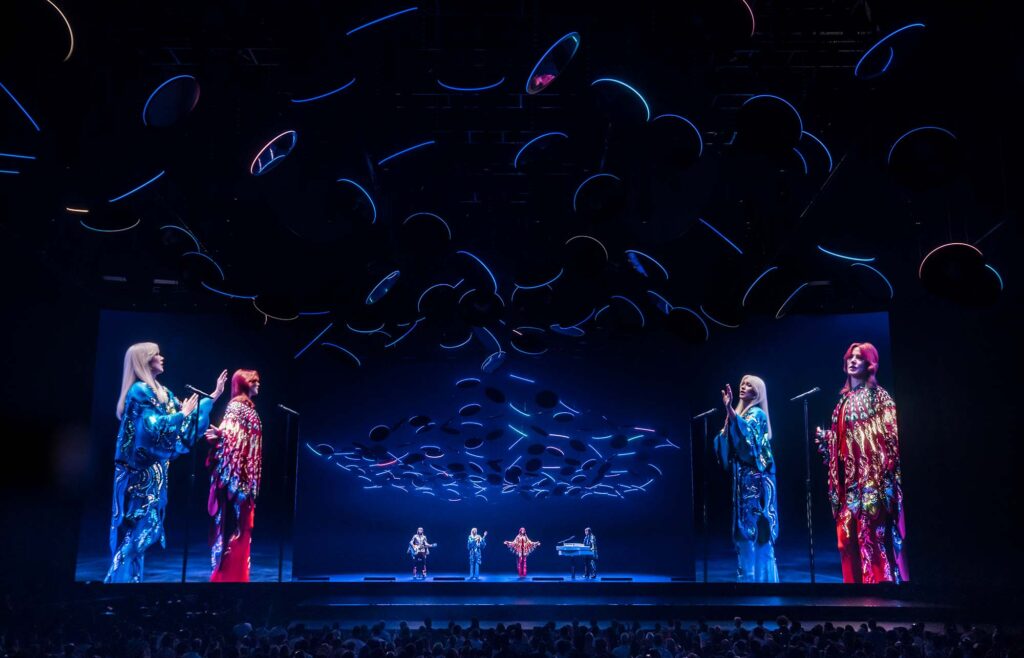ABBA Voyage's creators tell us how they made the show, and what's next
The team behind the creation of the new ABBA Voyage live experience have spoken to NME about how it was made, as well as what could be next for both the show and the band. Watch our video interview above.
Premiering earlier this week at the purpose-built ABBA Arena in Stratford, East London, to a delighted response from fans, the ambitious production sees a “digital” version of ABBA (or ‘ABBAtars’) performing alongside a 10-piece live band (put together with the help of Klaxons’ James Righton).
Working on the show with ABBA were Svana Gisla (who produced Jay-Z and Beyoncé‘s On the Run Tour), choreographer Wayne McGregor, Johan Renck (who directed David Bowie‘s videos for ‘Blackstar’ and ‘Lazarus’), Baillie Walsh (who has directed for Massive Attack and Bruce Springsteen) and producer Ludvig Andersson (son of ABBA’s Benny Andersson and producer of And Then We Danced, Yung Lean‘s ‘In My Head’ and Mamma Mia! Here We Go Again).
“We did an awful lot of research and development on this, as you can imagine,” Gisla told NME from the red carpet. “We did two years of trying to figure out what this is. We put a lot of time into the philosophical side of it. This is not just about technology, this is about emotion. We wanted to understand the core of ABBA and the music and how to deliver it in 2022.
“A lot of this is about restraint. When all of the technology and everything is available to you, it becomes an exercise in restraint. The music is the guiding light.”
Gisla said that there was “nothing nostalgic about this concert apart from the music”, and that the whole approach was very forward-thinking.
“ABBA look like they did in 1979, but they’re firmly rooted in the now and in the future. Everything else is as forward as it can be,” she said. “You’re going to see a lot of things that you’ve never seen before. The feeling of being inside the arena will be unique, it’s very immersive. People use that word a lot, but when you go in there you’ll fully realise the capabilities of an immersive environment. It’s like being in the eye of the storm.”
Asked about how long the show could be set to run for, Gisla replied: “I don’t want to jinx it, but if this is a success then we can be here for a few years. We’re on borrowed land, we didn’t break any ground, the arena is moveable and we can pack up and leave when we aren’t wanted anymore.
“I hope the audience wants us to stay for a bit, because we feel like we’ve made something really special.
Director Baillie Walsh, meanwhile, said it was surreal that the “dream” from inside his head finally now on the stage for people to see. Walsh sternly denied that what fans would be seeing was “a hologram”, and in fact something quite different.
“We filmed ABBA for five weeks,” he said. “Wayne McGregor extended their moves into younger bodies – our doubles – and we blended those performances together. Now we have our 2022 ABBA.
“It was very emotional every day. It was like NASA in having so many people in the studio every day, but the whole studio were in tears most days. It was really extraordinary.”
Asked why it was necessary to build their own venue for the project, Walsh said that it was needed to match the ambition of the concept.
“ABBA’s ambition for this project was a beautiful thing, and it was a creative ambition, rather than a money-making exercise,” he said. “Building the arena was just part of that. You can have more lights because you’re not moving around from venue to venue and it’s bespoke. I could design the show around this building.”
As for how long the show could be set to run in London for, he said: “It’s up to the fans really. I hope it’s a destination for a long, long time.”
It is now believed that the concept could be copied for other veteran acts, but Walsh said it might not be so easy to imitate.
“ABBA were so involved in this,” he said. “They’re the heart and soul of it. There aren’t many bands like ABBA around. A posthumous show wouldn’t have the same kind of feeling. The fans know that ABBA are involved and that this isn’t a cynical exercise. This is ABBA.”

Choreographer Wayne McGregor agreed – detailing what went in to capturing the pop icons’ dance moves and movements.
“We’re using a process called motion capture, which you’ve probably seen in movies,” he said. “We use these little dots to take the maths out your body. We take all these zeroes and ones and put them into a computer and build an avatar. It’s a long process. It captures the essence of you, but then we really have to work into that.
“I was taking dance moves from them – I wouldn’t dare show ABBA dance moves. I just wanted them to be themselves and get them back into their performance energy, because they haven’t performed for a while. Then I had to work with the body doubles to transform some of that amazing physical from the ‘70s into maths and find a way of combining the two.”
Enjoying those weeks of having the band perform and sing before him, McGregor described their time together as “perfect”.
“It’s insane to have those amazing performers sing their whole catalogue in front of you,” he said. “They were so bold, brave and into it. It was really exciting. How amazing is it to have this legacy project where you can see ABBA over and over again? It’s a piece of theatre, a piece of performance, a concert like no other. You really feel like you’re inside the music and that’s fabulous.”
He added: “For this show, the technology marries emotion and brings the emotion of those songs directly into you. I love the fact that audiences can actually come in and dance while watching. I’ll be back, every Friday night!”
Co-executive producer Renck, said that he ranked his experience of working with ABBA among his bucket-list projects of working with Bowie, but “in a very different capacity”.
“My entire upbringing was about music,” he told NME. “Everything that is me is music in one way or another. It’s the most important thing for me ever, and the life journey of being seven or eight-years-old and my mother playing ABBA in the car to being here now is a pretty substantial thing, isn’t it?”
He remained coy about details of the show itself, but said: “I’m not going to tell you anything because it’s better to just come and witness it. It’s a very unique experience in all sorts of ways. Whether you’re an ABBA fan or not.
“I’m using the word ‘experience’ a lot, but it takes you to a place you haven’t been before.”

We also asked each of the team if they felt that this really could be the last we see of ABBA.
“I think this is the final thing,” replied Gisla. “They’re quite genuine in that, but they’ve said that before. I think this is it. It took a lot to make and it was hard work, from us and from them.”
Walsh also said that he “didn’t think” ABBA would reunite for any projects again, while Renck added: “Who knows? I’m sure that some of these four do not see it as an endgame, in any shape or form. Benny is music, that’s what he lives, breathes and does every day. That’s never going to stop. Whatever iteration that comes out, who knows? But I don’t think there’s any kind of punctuation to be had.”
Watch our full video interview with the creators of ABBA Voyage at the top of the page.
All four members of ABBA also spoke to NME on the red carpet, telling us about the experience of reuniting and what might be on the horizon for the band.
When asked if the concert was a parting gift from the band, Björn Ulvaeus said: “I think this is it. It’s sad to say that but then again, you can always take it back, can’t you? So the answer is, it could be yes, it could be no.”
Meanwhile, Benny Andersson joked: “This is what you’ll see, this is what you’ll get. Then we’ll go home and we’ll sleep.”
In a five star review of ABBA Voyage, NME concluded: “Ageing rockers and poppers are bound to imitate the idea, but it’ll be a struggle to come close to the experience of ABBA Voyage. We for one welcome our new ABBAtar overlords, if only for giving these songs back to us in a totally new and joyful way.”




